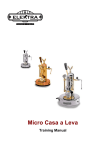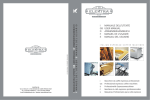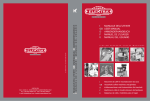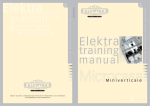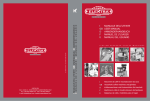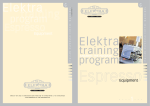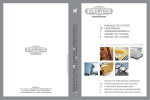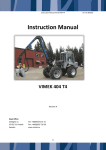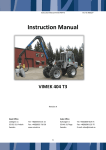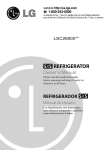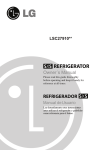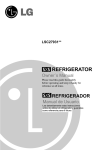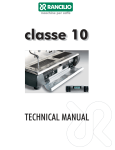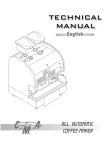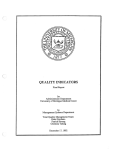Download MANUALE OK 09_cs4.indd
Transcript
I MANUALE DELL’UTENTE GB USER MANUAL D ANWENDERHANDBUCH F M A N U E L D E L’ U S A G E R E M A N U A L D E L U S U A R I O A.D.: Holbein & Partners - COD. 03662035 - Edition: April 2009 ELEKTRA SRL VIA A. VOLTA,18 - 31030 DOSSON DI CASIER (TREVISO) ITALY TEL. (+39) 0422 490405 R.A. - FAX (+39) 0422 490620 E-mail: [email protected] - Website: www.elektrasrl.com I GB D F E MANUALE DELL’UTENTE USER MANUAL ANWENDERHANDBUCH MANUEL DE L’USAGER MANUAL DEL USUARIO I T A L I A N E S P R E S S O C O F F E E M A C H I N E S I Macchine da caffè espresso professionali GB Professional espresso coffee machines D Professionelle Espressomaschinen F Machines à café expresso professionnelles E Máquinas Profesionales para café espresso ITALIAN ESPRESSO COFFEE MACHINES 3 gb 48 gb gb 49 gb CONTENTS A INTRODUCTION 53 B GENERAL RECOMMENDATIONS AND SAFETY REGULATIONS 54 C DESCRIPTION OF THE APPLIANCE 56 1 2 3 4 5 6 7 8 9 10 11 12 13 14 15 16 17 18 19 20 21 COFFEE DISPENSING DISPENSING OF HOT WATER AND STEAM ELIMINATION OF CALCIUM AND MAGNESIUM SALTS FROM THE WATER ELIMINATION OF CALCIUM AND MAGNESIUM SALTS FROM THE WATER AUTOMATIC REGENERATION OF THE WATER SOFTENER RESINS ELIMINATION OF CHLORINE AND ORGANIC COMPOUNDS FROM THE WATER CONTROL OF WATER LEVEL IN THE BOILER CONTROL OF WATER TEMPERATURE IN THE BOILER STABILIZING THE BREWING TEMPERATURE MEASURING THE BREWING PRESSURE MEASURING THE BREWING PRESSURE MEASURING THE WATER SUPPLY PRESSURE PROTECTING THE HEATING ELEMENTS PROTECTING FROM OVERHEATING UPPER CUP TRAY UPPER CUP HEATER TRAY DRIP TRAY USER ALERTS USER ALERTS BASIC PROGRAMMING SPECIAL PROGRAMMING (K-Kwts-S-M-C-B) (K-Kwts-S-M-C-B) (K-S-M-C-B) (Kwts) (Kwts) (Kwts) (K-Kwts-S-M-C-B) (K-Kwts-S-M-C-B) (K-Kwts-S-M-C-B) (K-S-M-C-B) (Kwts) (Kwts) (K-Kwts-S-M-C-B) (K-Kwts-S-M-C-B) (S-M-C-B) (K-Kwts) (K-Kwts) (S-M-C-B) (K-Kwts) (K-Kwts-S-M-C-B) (K-Kwts) D UNPACKING 60 E INSTALLATION 1 2 3 4 5 6 7 8 9 10 11 50 ADJUSTING THE FEET WATER CONNECTIONS WATER CONNECTIONS WATER SOFTENER CONNECTION WATER SOFTENER CONNECTION CONNECTION WITHOUT WATER SOFTENER DRAIN CONNECTION ELECTRICAL CONNECTIONS FILLING THE HYDRAULIC CIRCUITS FILLING THE HYDRAULIC CIRCUITS FLUSHING THE MACHINE (USA NSF requirements) 56 56 56 56 56 56 56 57 57 57 57 57 57 57 57 58 58 58 58 59 59 61 (K-Kwts) (K-S-M-C-B) (Kwts) (K-S-M-C-B) (Kwts) (Kwts) (K-Kwts-S-M-C-B) (K-Kwts-S-M-C-B) (K-S-M-C-B) (Kwts) (K-Kwts-S-M-C-B) 61 61 61 62 62 62 63 63 64 64 65 1 2 3 4 5 6 7 8 9 SELECTION OF LANGUAGE SETTING OF DATE AND TIME STORING OF MEASURED WATER SUPPLY HARDNESS STORING OF WATER SOFTENER TYPE ADJUSTING THE BREWING TEMPERATURE ADJUSTING THE BREWING PRESSURE ADJUSTING THE SALINITY OF THE BREWING WATER PROGRAMMING OF COFFEE DOSES PROGRAMMING OF NIGHT CYCLE (K-Kwts) (K-Kwts-S-M-C-B) (Kwts) (Kwts) (K-Kwts-S-M-C-B) (K-Kwts-S-M-C-B) (Kwts) (K-Kwts-S-M-C-B) (K-Kwts-S-M-C-B) G USE 1 2 3 4 5 6 7 8 9 10 11 12 13 14 SWITCHING ON USE OF THE WORKING AREAS USE OF THE WORKING AREAS USE OF THE WORKING AREAS COFFEE DISPENSING WITH MANUAL DOSING COFFEE DISPENSING WITH AUTOMATIC DOSING COFFEE DISPENSING WITH AUTOMATIC DOSING BUT WITH POSSIBILITY OF STOPPING IT MANUALLY WARMING THE CUPS WARMING THE CUPS MAKING THE COFFEE MAKING CAPPUCCINO, MILK AND OTHER HOT DRINKS MAKING TEA – CAMOMILE TEA - ETC USING BASIC PROGRAMMING USING BASIC PROGRAMMING 69 (K-Kwts-S-M-C-B) (M-B) (S-C) (K-Kwts) (K-Kwts-S-M-C-B) (K-Kwts-S-M-C-B) 69 69 69 70 70 70 (S-M-C-B) (S-M-C-B) (K-Kwts) (K-Kwts-S-M-C-B) (K-Kwts-S-M-C-B) (K-Kwts-S-M-C-B) (S-M-C-B) (K-Kwts) 70 71 71 71 71 72 72 79 H MAINTENANCE AND CLEANING 1 2 3 4 5 6 7 8 9 10 11 DAILY CLEANING OF THE GROUPS AND FILTERHOLDERS DAILY CLEANING OF STEAM WANDS WEEKLY CLEANING OF THE GROUPS WEEKLY CLEANING OF THE FILTERS AND FILTERHOLDERS WEEKLY CLEANING OF LOWER DRIP TRAY WEEKLY CLEANING OF BODY CLEANING THE WATER SOFTENER REGENERATING THE WATER SOFTENER RESINS REGENERATING THE WATER SOFTENER RESINS CHANGING THE ACTIVATED CARBON CARTRIDGE RINSING THE WATER TREATMENT CIRCUIT 67 67 67 67 67 67 68 88 68 80 (K-Kwts-S-M-C-B) (K-Kwts-S-M-C-B) (K-Kwts-S-M-C-B) (K-Kwts-S-M-C-B) (K-Kwts-S-M-C-B) (K-Kwts-S-M-C-B) (K-S-M-C-B) (K-S-M-C-B) (Kwts) (Kwts) (Kwts) 51 80 80 80 80 80 80 80 81 82 82 82 gb 67 F ADJUSTMENTS 83 I DATA MANAGEMENT gb 1 2 3 4 5 DISPLAY OF FUNDAMENTAL PARAMETERS DISPLAY OF FUNDAMENTAL PARAMETERS DISPLAY OF FUNDAMENTAL PARAMETERS DISPLAY AND RESET OF COFFEE PRODUCTION DISPLAY AND RESET OF WATER CONSUMPTION (S-M-C-B) (K) (Kwts) (K-Kwts) (K-Kwts) J TROUBLESHOOTING 1 2 3 4 5 6 7 8 9 10 11 12 13 14 15 16 17 18 WARNING: BUFFER BATTERY ABOUT TO GO FLAT STEAM DOES NOT COME OUT OF THE WAND WHEN THE MACHINE IS HOT WARNING: WATER LEVEL CONTROL SYSTEM FAULT WATER COMES OUT OF THE STEAM WAND FLASHING OF THE PUSHBUTTON LED DURING DISPENSING WARNING OF NOT SATISFACTORY BREWING AND FLASHING OF THE DISPENSING PUSHBUTTON LED WATER DOES NOT COME OUT OF THE DISPENSING GROUP WHEN THE MANUAL BUTTON IS USED ONE DISPENSING GROUP STARTS UP ON ITS OWN WARNING: INADEQUATE WATER SUPPLY PRESSURE WARNING: NO WATER IN THE BOILER WARNING: BREWING TEMPERATURE CONTROL FAULT ONE DISPENSING GROUP DOES NOT HEAT SUFFICIENTLY THE GAUGE SHOWS A BOILER PRESSURE NOT BETWEEN 0.6 AND 1.6 BAR THE GAUGE SHOWS A BREWING PRESSURE NOT BETWEEN 8 AND 9 BAR WARNING: WATER SOFTENING SYSTEM FAULT NO SALT LOADING THE WATER SOFTENER AND ACTIVATED CARBON CARTRIDGE CAPS DO NOT OPEN THE DRIP TRAY IS FULL AND OVERFLOWING WITH WATER 84 (K-Kwts-S-M-C-B) 84 (K-Kwts-S-M-C-B) (K-Kwts-S-M-C-B) (K-Kwts-S-M-C-B) (S-M-C-B) 84 84 85 85 (K-Kwts) 85 (K-Kwts-S-M-C-B) (M-B) (Kwts) (K-Kwts-S-M-C-B) (K-Kwts-S-M-C-B) (K-Kwts-S-M-C-B) 85 86 86 86 86 87 (S-M-C-B) 87 (S-M-C-B) (Kwts) (Kwts) 87 87 88 (Kwts) (K-Kwts-S-M-C-B) 88 89 K DISPOSAL OF THE APPLIANCE L 1 2 90 TYPE APPROVALS EUROPEAN TYPE APPROVALS AMERICAN TYPE APPROVALS 83 83 83 83 83 91 (K-Kwts-S-M-C-B) (S-M) 91 91 M TEST DOCUMENTATION 218 N GUARANTEE 219 52 This manual applies to the entire range of professional coffee machines manufactured by ELEKTRA. Each topic has been specifically treated in a separate paragraph for each model belonging to the range, indicating the title of the paragraph itself and the models to which it refers, using the letters shown below: - K= Kwts = S= M= C= B= K model Kwts model SIXTIES model MODERN and GOLD models CLASSIC model BELLE EPOQUE model (Compact) (Maxi and Extramaxi) (Barlume) (Vertical 2-3 units) The SIXTIES model Deliziosa is not included; see the user’s manual October 2007 edition for this model. The manual contains all the instructions required for the installer, the operator (barman) and the manager or owner of the bar. It also contains some useful recommendations for guiding the service technician in the event of malfunctioning. U.S.A. - ATTENTION: These instructions include some particular specifications for the US and Canadian markets. 53 gb A INTRODUCTION B GENERAL RECOMMENDATIONS AND SAFETY REGULATIONS gb 1 2 3 4 54 This booklet is an essential and integral part of the product and must be given to the user. It contains basic safety instructions that must be followed for the installation, operation and maintenance of the appliance. Save these instructions. After having unpacked the appliance, make sure it is intact. If in doubt, do not use the appliance and contact a qualified engineer. The packing elements (plastic bags, polystyrene foam, nails, etc.) should not be left within reach of children since they are potential sources of danger. Before connecting the appliance, check that the mains electricity supply corresponds to the data given on the rating plate. The rating plate is located under the drip tray (K-Kwts-S-M-C) or inside the upper cup tray (B). The appliance should be installed by a qualified engineer according to the manufacturer’s instructions and in compliance with current safety regulations. Incorrect installation could cause injury to persons or animals and damage to property, for which the manufacturer cannot be held liable. This appliance is only electrically safe when it has been connected to an efficient grounding system in compliance with current safety regulations. Make sure that this fundamental safety requirement has been observed and if in doubt request a thorough check of the system by a qualified electrician. The manufacturer cannot be held liable for any damage that may be caused by failure to ground the appliance. Check that the current carrying capacity of the system is adequate for the maximum rated output of the appliance (as indicated on the rating plate). If in doubt, apply to a qualified technician. He should also make sure that the section of the cables is adequate for the power absorbed by the appliance. Do not use adapters, multiple current taps or extension cables. If it is absolutely necessary, only use plugs, simple or multiple adapters and extensions that comply with current safety regulations. Make sure, however, that the limit of current carrying capacity does not exceed that indicated on the simple adapter and extensions or the maximum power value indicated on the multiple adapter. This appliance should only be used for the purpose for which it was designed. Any other use is to be considered as unsuitable and therefore dangerous. The manufacturer cannot be held liable for any damage or injury caused by improper, wrong or unreasonable use. 6 7 8 9 10 11 12 55 gb 5 When using electrical appliances, basic safety precautions should always be followed: - the appliance should be used in environments where the temperature does not fall below 5 °C or rise above 40 °C; - the appliance has a water circuit containing water, which must not be allowed to freeze otherwise the appliance could be damaged; - the appliance should not be cleaned using water jets or installed in a place where water jets could be used for cleaning; - the appliance should be installed on the level – it must not slope; - do not touch the appliance when hands or feet are wet or damp; - do not operate the appliance barefoot; - do not use extension cables in bathrooms or shower-rooms; - do not tug the power supply cable to disconnect the appliance from the mains supply; - do not expose the appliance to the elements (rain, sun, etc.); - do not allow children or incompetent persons to use the appliance. Disconnect the appliance from the mains electricity supply before carrying out any maintenance, by pulling out the plug or by switching off at the mains switch. To clean the appliance, follow the instructions in this booklet. In the event of failure or malfunctioning of the appliance, switch it off and under no circumstances try to repair it yourself. Always request service by a qualified technician. Any repair, electrical or mechanical adjustment should only be carried out at the factory or by an authorized service center using only original spare parts. Failure to comply with these instructions could jeopardize the safety of the appliance. The appliance should be connected to the electricity supply through a multipolar linked switch having a contact separation of at least 3 mm in all poles, in compliance with current safety regulations. Unwind the whole power supply cable to prevent dangerous overheating. Do not obstruct the intake and outlet grilles. In particular do not cover the upper cup tray with a cloth or such like. The supply cable of this appliance should not be replaced by the user. Should the cable be damaged, switch off the appliance and apply solely to a qualified electrician for replacement. Should the machine be used no longer, it must be made inoperative by cutting the supply cable after having disconnected it from the electrical power supply. Make sure that all those parts which could be possible sources of danger are made harmless. C DESCRIPTION OF THE APPLIANCE The main functions of the machine, and its relative parts, are described below, with a view to ensuring its maximum performance. gb 1 COFFEE DISPENSING (K-Kwts-S-M-C-B) Independent dispensing groups with predosed or manual selections. Filterholders for one or two cups. 2 DISPENSING OF HOT WATER AND STEAM (K-Kwts-S-M-C-B) The machine has one or two steam wands and a hot water dispenser which allows the use of large milk or water containers thus guaranteeing good general ergonomics. 3 ELIMINATION OF CALCIUM AND MAGNESIUM SALTS FROM THE WATER (K-S-M-C-B) This enables the elimination of scale deposits in the machine thanks to a water softener that softens the water, eliminating the calcium and magnesium salts contained in it. The water softener is not incorporated in the machine and has an independent manual or automatic function. 4 ELIMINATION OF CALCIUM AND MAGNESIUM SALTS FROM THE WATER (Kwts) This enables scale deposits to be removed from the machine. It consists of an ion exchange resin water softener, completely and automatically managed by the machine. 5 AUTOMATIC REGENERATION OF THE WATER SOFTENER RESINS (Kwts) When the resins in the water softener are used up, all the operator has to do, on receiving the automatic prompt from the machine, is to load the salt. During regeneration, the system automatically excludes the water treatment circuit from the machine water supply, allowing the machine to operate without it. 6 ELIMINATION OF CHLORINE AND ORGANIC COMPOUNDS FROM THE WATER (Kwts) Removes the bad taste and deposits caused by the Chlorine and eliminates bacteria, making the water purer. It consists of a silver-loaded activated carbon cartridge fitted inside the machine, at the water supply inlet. The system signals the exhaustion of the cartridge in relation to the volume of water that it has treated and excludes it automatically from the machine water supply circuit, allowing the machine to continue operating without it. 7 CONTROL OF WATER LEVEL IN THE BOILER (K-Kwts-S-M-C-B) This is done by means of a level probe which controls the water level in the boiler, topping it up automatically when required. 56 8 CONTROL OF WATER TEMPERATURE IN THE BOILER (K-Kwts-S-M-C-B) gb This keeps the temperature of the coffees constant as opposed to the temperature and the pressure of the steam. Consequently, it also controls the pressure in the boiler. 9 STABILIZING THE BREWING TEMPERATURE (K-Kwts-S-M-C-B) Each dispensing group has a heating circuit for brewing water that functions with a heat exchanger. This circuit ensures that the dispensing group remains at a constant and optimal temperature even when it is not being used thanks to the effect of the natural circulation of hot water flowing through the circuit itself. 10 MEASURING THE BREWING PRESSURE (K-S-M-C-B) This enables the manual regulation of pump pressure during coffee dispensing. The pressure is displayed on the gauge clearly visible in the working area. On the K model, the gauge is fitted inside the machine. 11 MEASURING THE BREWING PRESSURE (Kwts) Through the reading of the display, this enables the manual regulation of pump pressure during coffee dispensing. 12 MEASURING THE WATER SUPPLY PRESSURE (Kwts) Enables automatic protection in the event of a water supply stoppage. 13 PROTECTION OF THE HEATING ELEMENTS (K-Kwts-S-M-C-B) This consists of a safety level probe that triggers the cutting off of power to the heating elements. Resetting takes place through Basic Programming. See chapter “G – USE”. 14 PROTECTION FROM OVERHEATING (K-Kwts-S-M-C-B) In each of following cases: - Excessive duration of heating - Exceeding of maximum allowable temperature value, the heating elements are disabled and a major fault is reported. 15 UPPER CUP TRAY (S-M-C-B) These models are equipped with cup heater trays with the capacity to contain a large number of cups on various levels and to keep them warm in order to guarantee an excellent cup of coffee. The heat is generated by a natural flow of hot air from the inside of the machine. 57 gb 16 UPPER CUP HEATER TRAY (K-Kwts) Models equipped with larger cup heater trays and electric heating with automatic temperature control. The heating can either be enabled or disabled. 17 DRIP TRAY (K-Kwts) Improves the draining and cleaning of the work counter. Avoids blocking of the drain. 18 USER ALERTS (S-M-C-B) The machine can give the user a series of alerts through different LED light on/off combinations for each coffee dispensing button, on each of the two or three groups on the machine. Symbols are used in this manual to indicate these alerts as follows: Group 1 Group 2 Group 3 Led all off: Led of the long single coffee button of group 1 on with fixed light: Led of the long single coffee button of group 1 flashing: Led of the long single coffee button of group 1 slowly fading light: Slow flashing led sequence: Fast flashing led sequence: 19 USER ALERTS (K-Kwts) The machine can give the user a series of alerts written in the selected language through an alphanumeric display arranged along two rows with sixteen characters each. The writing may be fixed, scrolling or fixed but divided over two or more screen displays if very long: wait and read the complete written message to ensure you fully understand the alert. 58 This enables the implementation of some of the Adjustment, Maintenance and Data Management functions. It also facilitates the providing of telephonic assistance. Basic Programming is the exclusive responsibility of the installer/service technician or of the owner of the business . It is carried out using the key provided. These functions are as follows: - Selection of the language Setting of date and time Setting of increase (or decrease) of brewing temperature Storage of measured water hardness Selection of softener type Programming of coffee doses Programming of night cycle Reset of heating element safety device Rinsing of the water treatment circuit Reset of scheduled maintenance call Reset of activated carbon cartridge changing alert Display and reset of coffee production Display and reset of water consumption (K-Kwts) (K-Kwts-S-M-C-B) (K-Kwts-S-M-C-B) (Kwts) (Kwts) (K-Kwts-S-M-C-B) (K-Kwts-S-M-C-B) (K-Kwts-S-M-C-B) (Kwts) (K-Kwts) (Kwts) (K-Kwts) (K-Kwts) 21 SPECIAL PROGRAMMING (K-Kwts) This allows the personalization of certain machine functions according to important servicing, marketing or individual end Customer requirements Special Programming is the exclusive responsibility of the dealer’s specialized technician who will have been specifically trained by ELEKTRA to do so. Special Programming should be carried out on the dealer’s premises prior to installation. It is carried out via PC by connecting a special cable to the machine’s electronic control unit and the ELEKTRA program. These functions are as follows: - Setting of preventive maintenance program. Activation of start of dispensing only upon reaching the ideal brewing temperature. Activation of brewing suitability control according to Italian espresso standards. Activation of a maximum time between one regeneration and another (WTS version only). Personalization of maximum coffee dispensing time. Personalization of the maximum heating element “on” time. Personalization of the reset code for the scheduled maintenance call, coffee production and water consumption. Saving and printing of all machine configuration data. Saving and printing of all machine cumulative historical data. 59 gb 20 BASIC PROGRAMMING (K-Kwts-S-M-C-B) D UNPACKING gb Packaging is carried out with the aim of protecting the machine from damage during transportation. The packaging materials used are recyclable. They are, therefore, chosen according to environmental protection criteria and ease of disposal, the latter process being geared at further integration in productive cycle materials. Thanks to this mechanism, not only is the volume of waste reduced but a more rational use of non renewable resources is also ensured. 1) Cut the strap that keeps the box closed. 2) Open the top of the box and remove the shock-proof panels inside, remove the accesso ries contained inside them and take out the present manual, keeping these articles to hand for the later phases of use of the appliance. Remove the nylon bag covering the upper part of the machine and put it in a safe 3) place out of the reach of children. 4) Working with at least one other person, grasp the base of the machine from inside the box and remove it by lifting it upwards. 5) Remove any other packaging materials and protections attached to the machine. 6) Hand the packaging materials over to an authorized enterprise for disposal and recycling. 60 Installation must be carried out exclusively by a specialized technician from the Technical Assistance Service. The company Elektra declines any and all responsibility for tampering or interventions carried out by non authorized persons. Such intervention automatically renders the guarantee null and void. ATTENTION: (USA NSF requirements) The equipment is to be installed to comply with the Basic Plumbing Code of the Building Officials and Code Administration International, Inc. (BOCA) and the Food Service Sanitation Manual of the Food and Drug Administration (FDA). 1 ADJUSTING THE FEET (K-Kwts) Place the machine on the work counter and ensure that it is level, by adjusting the length of the feet. Turn the chrome-plated foot counter-clockwise, when viewed from underneath, to lengthen it and clockwise to shorten it. There are no screws or nuts to be loosened or tightened. 2 WATER CONNECTIONS (K-S-M-C-B) The water is fed thanks to a connection with the drinkable water supply at a minimum pressure of 1.5 bar and a maximum pressure of 4 bar. Should the water supply pressure exceed 4 bar, install a pressure reducer upline of the coffee machine / water softener system. An external check-valve may be required to meet local regulations. The machine has a flexible steel-braided connection pipe with a 3/8 female connection, approx. 1.5 metres in length. 1) Connect the flexible pipe to the coupling located on the bottom of the machine. 2) If the machine is being installed without a water softener (not recommended unless a centralized water softening system has been installed) connect the flexible pipe to the water supply. 3 WATER CONNECTIONS (Kwts) The water is fed thanks to a connection with the drinkable water supply at a minimum pressure of 1.5 bar and a maximum pressure of 4 bar. Should the mains pressure exceed 4 bar, install a pressure reducer upline of the coffee machine/water softener system. An external check-valve may be required to meet local regulations. The machine has three flexible connecting pipes with 3/8 female connections, approx. 1.5 metres in length. 1) Connect each flexible pipe to the couplings located on the bottom of the machine. The three couplings are marked “1”, “2” and “W”. 2) Flush the water supply to ensure that it is clean and after couple to it the flexible pipe coming from the “W” coupling. Do not open the water supply. 61 gb E INSTALLATION 4 WATER SOFTENER CONNECTION (K-S-M-C-B) gb If the standard water softener with completely manual valves is to be used, follow the instructions below. If semiautomatic or automatic water softeners are to be used, follow the specific instructions provided in the handbooks accompanying the water softeners themselves. The water softener has a flexible steel-braided connecting pipe with 3/8 female connections, approx. 0.7 metres in length, and a semitransparent pipe approx. 0.7 metres in length. 1) Flush the water supply to ensure that it is clean. Couple the 0.7 metre long flexible pipe to the water softener inlet (upper valve) and the water supply. 2) Ensure that the valve levers are in the vertical position. 3) Allow at least 10 litres of water to flow through the water softener by turning on the water supply, turning the upper valve lever counter-clockwise and the lower valve lever slightly counter-clockwise. 4) Only reclose the lower valve, by turning it to the vertical position, when the water is clear and colourless. 5) Connect the 1.5 metre long flexible pipe, previously hooked up to the machine, to the lower valve of the water softener. 6) Cut the semitransparent pipe into two pieces, one 0.4 metres long and the other 1.3 metres long. 7) Connect the shorter piece to the pipe-end fitting of the upper valve. 8) Connect the longer piece, rolled up, to the pipe-end fitting of the lower valve, after ensuring that the gigleur is well-tightened to the fitting itself. 9) Turn the lower valve lever counter-clockwise so as to feed the machine. 5 WATER SOFTENER CONNECTION (Kwts) The machine must only be used with the three types of special water softener supplied by ELEKTRA, i.e.: 8 litre ELEKTRA water softener - 12 litre ELEKTRA water softener - 16 litre ELEKTRA water softener No other type or brand of water softener may be used with this model. 1) Connect the flexible pipe connected to coupling “1” on the machine to the corresponding coupling “1” on the water softener. 2) Connect the flexible pipe connected to coupling “2” on the machine to the corresponding coupling “2” on the water softener. Do not open the water supply. 6 CONNECTION WITHOUT WATER SOFTENER (Kwts) Although not recommended, the machine can be used without water softener if necessary. Contact Technical Assistance. 62 The machine has a rubber connecting pipe with pipe-end fitting, approx. 1.5 metres in length. This pipe must be made to flow into a fixed drain manifold with a minimum internal diameter of 35 mm located underneath the machine work counter. The space created by difference in diameter of the two pipes inserted one into the other must be left free for the venting of air during the discharging of the water. 1) Hook up the rubber pipe from the metal pipe or from the plastic drain box installed in the machine to the drain manifold located underneath the counter, ensuring that it does not sag and that it is not strangled. 8 ELECTRICAL CONNECTIONS (K-Kwts-S-M-C-B) The machine is equipped with a connecting power cable, approx. 2 metres in length, with 5 wires of the following colours: - Green/Yellow: - Blue: - Brown: - Black: - Grey: Ground Neutral Phase 1 Phase 2 Phase 3 The wires should, preferably, be connected to a terminal board on the electric switchboard; if a plug is to be used, it should be an industrial plug with a sufficient capacity to power the machine. The connection may be made without any modification being required to the machine, either to a single-phase 230VAC power supply or to a triple phase 400VAC N3 power supply, as follows: 8.1 SINGLE-PHASE 230VAC CONNECTION Hook up the Ground and Neutral wires to the two respective terminals on the electric switchboard. Join up the three wires of phases 1, 2 and 3 themshelves and connect them to the single terminal of the phase present in the electric switchboard. 8.2 THREE-PHASE 400VAC N3 CONNECTION Hook up the Ground and Neutral wires to the two respective terminals on the electric switchboard. Connect each of the three wires of phases 1, 2 and 3 to the respective terminals of the phases present in the electric switchboard. The wiring diagram and electrical data are shown on the two plates located underneath the drip tray (K-Kwts-S-M-C) or inside the upper cup tray (B). 63 gb 7 DRAIN CONNECTION (K-Kwts-S-M-C-B) gb 9 FILLING THE HYDRAULIC CIRCUITS (K-S-M-C-B) 1) Ensure that the water supply is turned on. 2) Switch on the machine by turning the main switch from position “0” to “1”: the machine goes on and loads water into the boiler, while powering the heating elements. 10 FILLING THE HYDRAULIC CIRCUITS (Kwts) Before switching on the machine, fill the water treatment hydraulic circuit. Proceed as follows: 1) Open the water softener cap. 2) Open the activated carbon cap and take the cartridge out. 3) Top up with water the cartridge container until the water softener has filled up completely and starts overflowing. 4) Close the water softener cap. 5) Put the activated carbon cartridge in, top up with water to the brim and reclose. 6) Turn on the water supply. Now the machine is ready to be switched on and adjusted. If there are problems in opening the two caps, consult chapter “J – TROUBLESHOOTING”. 64 ATTENTION The technician in charge of installing the appliance should carry out the following operations before going to install the equipment at the customer’s. ATTENTION: The unit should be flushed through prior to putting it into service. With reference to the hydraulic scheme given below, before putting it into service, the machine must be flushed through as follows: A) FLUSHING THE DELIVERY GROUP 1) Switch the machine on and make sure that it is up to pressure. 2) Let 5 liters of hot water flow from each delivery group N° 18 through the filter N° 19 located on the filter holder N° 21. B) 1) 2) 3) 4) FLUSHING THE BOILER Switch the machine on and make sure that it is up to pressure. Switch the machine off. Connect a rubber drainage hose to hot water tap N° 14 Open hot water tap N° 14 until the boiler is completely drained of water (time required: 2 minutes): Note: it is the boiler pressure that makes the water drain off. C) 1) 2) 3) 4) 5) 6) FLUSHING THE HEAT EXCHANGERS Remove the upper cup tray. Remove the pipe N° 23 and the injector of heat exchanger N° 8. Remove the upper cap of the heat exchanger N° 8. Wait until the heat exchanger is completely empty. Re-connect the pipes to heat exchanger. Reassemble the upper cup tray. 65 gb 11 FLUSHING THE MACHINE (USA NSF requirements) HYDRAULIC SCHEME gb 1 2 3 4 5 6 7 8 9 10 11 12 66 WATER SUPPLY WATER SOFTENER ENTRY WATER CONNECTION MOTOR / PUMP ONE WAY VALVE INLET SOL. VALVE BOILER HEAT EXCHANGER SAFETY VALVE VACUUM BRAKE VALVE FILTER OREFICE 13 14 15 16 17 18 19 20 21 22 23 STEAM VALVE HOT WATER VALVE EXPANSION VALVE GAUGE GROUP SOLENOID VALVE COFFEE DELIVERY GROUP FILTER WATER FLOW METER FILTERHOLDER HOT WATER COLD WATER F ADJUSTMENTS 1 SELECTION OF LANGUAGE (K-Kwts) gb This allows the conversion of all the communications made by the machine into Italian or English or French or Spanish or German. This is done through the Basic Programming. See chapter “G – USE”. 2 SETTING OF DATE AND TIME (K-Kwts-S-M-C-B) This is used to set the minutes, hours, days, months and year for correct night cycle management and dating of statistical data. This is done through the Basic Programming. See chapter “G – USE”. 3 STORING OF MEASURED WATER SUPPLY HARDNESS (Kwts) Together with the storing of the type of water softener, this allows the machine to automatically calculate the volume of softened water available before saturation of the softener resins and, consequently, to start the automatic regeneration process. Measure the hardness of the water supply using the ELEKTRA kit provided, expressed in French degrees (°F), and store it through Basic Programming (see chapter “G – USE”). Contact Technical Assistance. 4 STORING OF WATER SOFTENER TYPE (Kwts) This allows the machine to automatically calculate the volume of softened water available in combination with water supply hardness. Use Basic Programming to store the type of installed water softener (see chapter “G – USE”). Contact Technical Assistance. 5 ADJUSTING THE BREWING TEMPERATURE (K-Kwts-S-M-C-B) This allows the brewing temperature to be varied according user requirements, the blend being used or environmental conditions, with a view to obtaining the best “quality in the cup”. This is done by setting the required increase (or decrease) of the temperature in relation to the standard brewing temperature, measured in centigrade degrees (°C). The standard brewing temperature is that programmed by the manufacturer and is the same for all produced pieces of this model. This is done through the Basic Programming (see chapter “G – USE”). After varying the brewing temperature, make at least three espresso coffees per dispensing group to enable the new temperature to stabilize itself. 6 ADJUSTING THE BREWING PRESSURE (K-Kwts-S-M-C-B) With a view to obtaining the best “quality in the cup”, brewing pressure may be adjusted. Recommended pressure is between 8 and 9 bar. Contact Technical Assistance. 67 7 ADJUSTING THE SALINITY OF THE BREWING WATER (Kwts) gb With a view to obtaining the best “quality in the cup”, the taste of the brewing water may be varied by adjusting its salts concentration. Contact Technical Assistance. 8 PROGRAMMING OF COFFEE DOSES (K-Kwts-S-M-C-B) Through the guided making of single sample coffees and the setting of doubling factors, the desired doses on each of the four automatic keys for each group may be stored. This is done through the Basic Programming. See chapter “G – USE”. 9 PROGRAMMING OF NIGHT CYCLE (K-Kwts-S-M-C-B) Through the setting of a time of day, the machine enters into a state of partial operation during which the temperature in the boiler is kept at a very low temperature (preheating temperature) and buttons with automatic dosing are not enabled. Only the manual dosing buttons can be operated. When this period of time has elapsed, the machine resumes normal operation. This is done through the Basic Programming. See chapter “G – USE”. 68 ATTENTION: (USA NSF requirements) The unit must be flushed after 12 hours of inactivity. With reference to the hydraulic scheme enclosed on chapter “E – INSTALLATION”, once the suitable boiler pressure for correct use of the appliance has been reached and before putting it into service, the machine must be be flushed through as follows: 1) Let hot water flow from valve N° 14 into a suitable container for 10 sec; repeat this procedure 5 times. 2) Let 1 liter of hot water flow from each delivery group N°18 through the filter N° 19 located on the filterholder N° 21. 1 SWITCHING ON (K-Kwts-S-M-C-B) The machine switches on by pressing the button marked with the symbol . When the machine is switched on, it automatically loads water into the boiler and, only when the boiler is full does it switch on the heating, so as not to damage the heating elements. The two possible types of alert that are displayed are as follows: “WAIT: MACHINE IS HEATING UP” “MACHINE READY” If it is the time of the night cycle, the alert is: “MACHINE IN SLEEP MODE - NIGHT CYCLE” 2 USE OF THE WORKING AREAS (M-B) With these models, it is possible to work with traditional espresso coffee cups of up to 2.76 inches in height (dispensing groups) and with containers of up to 4.92 inches in height (water and steam wands). 3 USE OF THE WORKING AREAS (S-C) With these models, it is possible to work with cups or containers of up to 3.94 inches in height (dispensing groups) and with containers of up to 5.71 inches in height (water and steam wands). Using optional extensions for the filterholders, it is possible to work with traditional espresso coffee cups of up to 2.76 inches in height. 69 gb G USE 4 USE OF THE WORKING AREAS (K-Kwts) gb The machine is divided into a coffee dispensing area on the right and a steam and hot water dispensing area on the left. It is thus possible to work with containers of up to 2.76 inches in height or up to 5.71 inches in height, depending on the heights of the work counters used (dispensing groups) and with containers of up to 5.91 inches in height (water and steam wands). Positioning the coffee grinder on the right of the machine speeds up the serving of coffees, given its proximity to the dispensing groups. This subdivision ensures that two operators can use the machine at the same time, without obstructing one another – one serving teas and cappuccinos and the other serving coffees. Includes two independent grilles and a raised work counter for coffee area. 5 MANUAL DISPENSING OF COFFEE (K-Kwts-S-M-C-B) This allows coffees of different lengths to be dispensed each time by pressing the button marked “K” and repressing the same button when the desired dose has been dispensed. This function is enabled at all times, irrespective of the machine status - even in the case of a major fault - so as to enable washing or checks during repair operations. The following alerts are displayed: (Group 1 manual dispensing of coffee in progress) (Group 2 manual dispensing of coffee in progress) (Group 3 manual dispensing of coffee in progress) 6 COFFEE DISPENSING WITH AUTOMATIC DOSING (K-Kwts-S-M-C-B) Allows the dispensing of coffee in preset doses. This is carried out by pressing the buttons marked with the coffee symbol once only. Dispensing stops automatically once the preset dose has been dispensed. This function is only enabled when all the envisaged operating and protection conditions have been met and cannot normally be stopped manually. Alerts are displayed as per following example: (Group 2 dispensing of double short coffees in progress). 7 COFFEE DISPENSING WITH AUTOMATIC DOSING BUT WITH POSSIBILITY OF STOPPING IT MANUALLY (K-Kwts-S-M-C-B) Although not recommended, if necessary coffees can be dispensed with automatic dosing and with the possibility of stopping it manually. Contact Technical Assistance. 70 Place the cups on the upper cup tray and remove them when they are needed, according to a rotation system that allows them sufficient time to heat. Do not place cloths between the tray and the cups. Do not cover the cups with cloths or other materials . 9 WARMING THE CUPS (K-Kwts) Press the button marked with the symbol located to the side of the main switch. The heating goes off, also automatically, when the temperature of the cup heating tray exceeds the maximum value set. It comes back on automatically when the temperature drops below the minimum value set. 10 MAKING THE COFFEE (K-Kwts-S-M-C-B) 1) Detach the filterholder from the dispensing group by turning it towards the left, and fill the filter with the dose of ground coffee. 2) Level it out and press it with the tamper. Ensure that no grounds are left on the edges of the filter. This will ensure a better seal and prolong the life of the filterholder gasket. 3) Attach the filterholder to the dispensing group, turning it firmly towards the right. 4) Place the cups underneath the spouts and start dispensing. 5) When dispensing is over, leave the filterholder attached to the group until further dispensing is required. 6) When a new coffee is required, discharge the coffee cake into the waste drawer without striking too hard so as not to damage the edge of the filter. In order to obtain a good Italian-style espresso coffee, grinding is of fundamental importance. The espresso must be dispensed in approx. 25 seconds and must have, on average, a volume equivalent to approx. 25 cc (single short button). If the grinding is too coarse, it will produce an overheated espresso with no froth. If the grinding is too fine, it will produce an espresso with little froth. Good quality coffee is obtained by using a fresh, evenly ground blend (only obtainable if the coffee grinder has sharp blades) used in the correct quantities (approx. 7 grams per dose). It is important to have coffee been freshly ground because otherwise it rapidly loses its aroma and the fatty substances contained in it go rancid; it is therefore advisable to finish it before the end of the day and the closing of the bar. Warm cups contribute considerably to maintaining the quality of the espresso. 11 MAKING CAPPUCCINO, MILK AND OTHER HOT DRINKS (K-Kwts-S-M-C-B) In order to froth up the milk, which is essential for making cappuccino, half-fill a tall, narrow container with milk and proceed as follows: 1) Briefly open the steam valve so as to remove any water condensation that might have collected. 2) Place the container with the milk underneath the steam wand so that the spray nozzle touches the bottom. Open the steam valve and bring the milk to the desired temperature. 3) Lower the container so that the spray nozzle rises almost to the surface of the milk and, from this position, raise and lower the container repeatedly so that the spray nozzle enters and surfaces from the milk alternately. Continue until the milk has frothed up. To make the cappuccino add hot espresso coffee to the hot frothy milk. 71 gb 8 WARMING THE CUPS (S-M-C-B) 12 MAKING TEA – CAMOMILE TEA ETC. (K-Kwts-S-M-C-B) gb Draw hot water from the boiler using the water valve wand, then add the bag required to obtain the drink to be made. 13 USING BASIC PROGRAMMING (S-M-C-B) 1) Insert the key in the lock on the control panel, gently press and turn it clockwise: the machine automatically enters a state of partial operation suitable for programming. 2) Press any of the coffee buttons marked with the “+” sign to scroll the menu to find the required topic. 3) Press “ENTER”, which is the double short coffee button (central) marked by the symbol on each pushbutton panel, to confirm the choice of topic and access further instructions. To change numerical values press the “+” and “-“ keys to increase or decrease respectively. Then save the data by pressing “Enter”. 4) Upon completing programming or consultation of the various topics, turn the key counter-clockwise and remove it from the lock: the machine automatically resumes full operation. In general, therefore, the “+” key is used to select the topics or information required and both “+” and “-“ keys are used to change the parameters, but always with the possibility to restore the initial situation. Data are only saved definitively on pressing “Enter”. Carefully follow step by step the instructions given below, as they provide a complete guide to programming. These instructions are provided through the LED alert system. 72 13.1 TIME SETTING gb The menu to set the time is displayed as follows: The set time is displayed as follows: 0 1 2 3 4 5 6 7 8 9 10 11 12 13 14 15 16 17 18 19 20 21 22 23 73 13.2 BREWING TEMPERATURE INCREASE (OR DECREASE) SETTING gb The menu to set brewing temperature increase (or decrease) is displayed as follows: The increase/decrease of standard brewing temperature in °C is displayed as follows: -10 -9 -8 -7 -6 -5 -4 -3 -2 -1 0 1 2 3 4 5 6 74 13.3 COFFEE BREWING DOSES PROGRAMMING gb The menu to program coffee doses is displayed as follows: THE GROUP 1 SELECTION IS DISPLAYED AS FOLLOWS: The group 1 single short coffee selection is displayed as follows: The request to make the group 1 single short sample coffee is displayed as follows: Make a sample coffee by pressing the group 1 single short coffee button. Press the button again when the desired dose has been reached: the pushbutton led goes off and the dose is stored. The group 1 single long coffee selection is displayed as follows: The request to make the group 1 single long sample coffee is displayed as follows: The buttons marked with the double cup are self-programmed automatically by multiplying the respective single dose by a multiplying factor ranging from 1.5 to 2.5. The standard factory value is 1.8. The group 1 multiplying factor is displayed as follows: 1,5 1,6 1,7 1,8 1,9 2,0 2,1 2,2 2,3 2,4 2,5 75 gb THE GROUP 2 SELECTION IS DISPLAYED AS FOLLOWS: The group 2 single short coffee selection is displayed as follows: The request to make the group 2 single short sample coffee is displayed as follows: The group 2 single long coffee selection is displayed as follows: The request to make the group 2 single long sample coffee is displayed as follows: The group 2 multiplying factor is displayed as follows: 1,5 1,6 1,7 1,8 1,9 2,0 2,1 2,2 2,3 2,4 2,5 76 gb THE GROUP 3 SELECTION IS DISPLAYED AS FOLLOWS: The group 3 single short coffee selection is displayed as follows: The request to make the group 3 single short sample coffee is displayed as follows: The group 3 single long coffee selection is displayed as follows: The request to make the group 3 single long sample coffee is displayed as follows: The group 3 multiplying factor is displayed as follows: 1,5 1,6 1,7 1,8 1,9 2,0 2,1 2,2 2,3 2,4 2,5 77 13.4 NIGHT CYCLE PROGRAMMING gb The menu to program the night cycle is displayed as follows: The night cycle start time is displayed as follows: 0 1 2 3 4 5 6 7 8 9 10 11 12 13 14 15 16 17 18 19 20 21 22 23 The night cycle end time is displayed as follows: Codes of times the same as paragraph 13.4. 78 13.5 HEATING ELEMENT SAFETY DEVICE RESET gb The menu to reset the heating element safety device is displayed as follows: The heating element safety device activated status is displayed as follows: The heating element safety device unactivated status is displayed as follows: In this case, after having repaired the fault, press “ENTER” to reset. 14 USING BASIC PROGRAMMING (K-Kwts) 1) Insert the key in the lock on the control panel, gently press and turn it clockwise: the machine automatically enters a state of partial operation suitable for programming. 2) The instructions for the using the main menu appear on the display: after confirming by pressing “Enter” on the control panel, press any of the coffee buttons marked with the “+” sign to scroll the menu to reach the desired topic. 3) Press “Enter” to confirm the choice of the topic and access further instructions. To change numerical values press the “+” and “-“ keys to increase or decrease respectively. Then save the data by pressing “Enter”. 4) Upon completing programming or consultation of the various topics, turn the key counter-clockwise and remove it from the lock: the machine automatically resumes full operation. In general, therefore, the “+” key is used to select the topics or information required and both “+” and “-“ keys are used to change the parameters, but always with the possibility to restore the initial situation. Data are only saved definitively on pressing “Enter”. Carefully follow the instructions step by step as they appear on the display – they provide a complete guide to programming. 79 H MAINTENANCE AND CLEANING 1 DAILY CLEANING OF DISPENSING GROUPS AND FILTERHOLDERS (K-Kwts-S-M-C-B) gb Each evening or at least once a day, clean the group shower and the filterholder gaskets with a cloth or a sponge. Rinse the filters and filterholders in boiling water in order to remove the fatty deposits of the coffee. It is advisable to wash the inside of the filterholders and filters with a view to avoiding incrustations and coffee deposits which could fall off during coffee making, forming grounds in the cup. 2 DAILY CLEANING OF THE STEAM WANDS (K-Kwts-S-M-C-B The steam wands, used for heating drinks, must be cleaned immediately after use in order to safeguard against the formation of incrustations that could block the holes of the spray nozzle and also to ensure that the residue of previously heated drinks does not deteriorate, leading to the unhygienic formation of bacteria. 3 WEEKLY CLEANING OF THE GROUPS (K-Kwts-S-M-C-B) 1) Replace the normal filter fitted on the filterholder with the blind filter (without holes) provided. 2) Place 1/2 teaspoon or a tablet of detergent for coffee in the blind filter and couple it to the group to be cleaned. 3) Start and then stop dispensing at intervals of 4-5 seconds for 5-6 times. 4) Rinse the blind filter and couple the filterholder to the group again. 5) Continue dispensing until the detergent is finished. 6) Make a coffee in order to eliminate any unpleasant tastes. 4 WEEKLY CLEANING OF THE FILTERS AND FILTERHOLDERS (K-Kwts-S-M-C-B) 1) Place three teaspoons of detergent for coffee machines and approx. one litre of boiling water in a heat-resistant container. 2) Immerse the filters and filterholders in the solution prepared and allow them to soak for about 20/30 minutes (do not fully immerse filterholders with briarwood handles: the water and detergent solution would damage the handles). 3) Rinse thoroughly under running water. 5 WEEKLY CLEANING OF THE DRIP TRAY (K-Kwts-S-M-C-B) At least once a week remove the lower cup grille, remove the drip tray and clean it. Check and clean the drain box too, removing any dregs with the aid of a teaspoon, and then rinse it. 6 WEEKLY CLEANING OF THE BODY (K-Kwts-S-M-C-B) Simply use a damp (non abrasive) cloth. Do not use alcohol or solvents to clean written or painted parts as this could damage them. 7 CLEANING THE WATER SOFTENER (K-S-M-C-B) 1) Periodically clean the gigleur fitted on the lower water softener valve by unscrewing it and ensuring that the water hole is not clogged. 2) Refit it on the valve and tighten it. 80 REGENERATION OF THE WATER SOFTENER RESINS (K-S-M-C-B) After the water softener resins have removed a given quantity of calcium and magnesium salts from the water (water hardness) they rapidly become saturated, losing their softening capacity. This capacity is completely restored through regeneration, which is carried out by washing in a salt and water solution. The efficiency of the water softener will guarantee constantly good coffee quality as well as the high performance and long life of the machine. Maintenance is also reduced as scale deposits are not allowed to form in the hot water hydraulic circuit. Regeneration must be carried out at a maximum frequency of once a week, depending on the following parameters: - Size of the water softener - Hardness of the water - Water consumption If the size of the water softener is increased, regeneration may be done less frequently. The opposite is the case if the other two parameters increase. As a general reference, with an 8 litre water softener and a water consumption of approx. 25 litres per day, with a water hardness of 30° French degrees, regeneration may be carried out once every 4 weeks. If, on the other hand, the hardness of the water were 60° French degrees, it would have to be carried out once every 2 weeks. If a standard water softener with completely manual valves is installed, follow the instructions below. If semiautomatic or automatic water softeners are installed, follow the specific instructions provided in the handbooks accompanying the water softeners themselves. 1) 2) 3) 4) 5) 6) 7) 8) 9) 10) 11) 12) 13) 14) Switch off the machine. Turn off the water supply. Vent the softener’s internal pressure by turning the upper valve lever clockwise: water will flow out of the semitransparent flexible pipe. Close the discharge by returning the upper valve lever to the vertical position. Open the softener upper cap. Pour the following amount of common coarse salt into the softener: - 8 litre softener 1.0 kg - 12 litre softener 1.5 kg - 16 litre softener 2.0 kg Close the softener cap after ensuring that it is full to the brim with water and that no salt residue has been left on the edges of the cap seal. Turn the upper valve lever totally counter-clockwise. Unroll the semitransparent pipe of the lower valve and allow its contents to flow into a general drain or a bucket. Turn the lower valve lever totally clockwise. Turn the water supply on: the washing of the resins with the salt solution has begun, and the liquid will be discharged through the semitransparent pipe. Continue the resin washing process for an hour. Then ensure that the liquid flowing out of the semitransparent pipe attached to the lower valve is fresh water (i.e. not salt water). Turn the lower valve lever totally counter-clockwise and roll up the semitransparent pipe, detaching it from the discharge outlet. Switch on the machine: the regeneration process has been completed. 81 gb 8 9 REGENERATION OF THE WATER SOFTENER RESINS (Kwts) When the following alert appears on the display: gb “LOAD SALT AND PRESS ENTER-MACHINE ON”, proceed as follows: 1) Open the water softener cap 2) Pour the amount of common coarse salt indicated on the packet label into the water softener, i.e.: - 8 litre water softener 1.0 kg - 12 litre water softener 1.5 kg - 16 litre water softener 2.0 kg 3) Close the softener cap after ensuring that it is full to the brim with water and that no salt residue has been left on the edges of the cap seal. 4) Press “ENTER” to confirm salt loading. If it is difficult to open the cap or if salt loading is erroneously confirmed prior to being effectively loaded, consult chapter “J – TROUBLESHOOTING”. 10 CHANGING THE ACTIVATED CARBON CARTRIDGE (Kwts) When the following alert appears on the display: “EXHAUSTED ACTIVATED CARBON CARTRIDGE - MACHINE ON - REPLACE IMMEDIATELY AND THEN RESET THIS ALERT USING THE PROGRAMMING KEY”, contact Technical Assistance. 11 RINSING THE WATER TREATMENT CIRCUIT (Kwts) This is done through the Basic Programming (see chapter “G - USE”). This allows rinsing of the water softener circuit and the activated carbon cartridge to be carried out after repairs or salt loading errors, by automatically excluding it from the machine water supply, enabling the machine to continue operating. 82 I DATA MANAGEMENT 1 DISPLAY OF FUNDAMENTAL PARAMETERS (S-M-C-B) gb The following operating parameters can be read on the dual pressure gauge: - Boiler pressure. - Water supply pressure (with pump off). - Brewing pressure (with pump on). 2 DISPLAY OF FUNDAMENTAL PARAMETERS (K) When “Enter” is pressed, the following operating parameters are displayed for a given time, one after the other: - Boiler pressure. - Set increase (or decrease) of brewing temperature. 3 DISPLAY OF FUNDAMENTAL PARAMETERS (Kwts) When “Enter” is pressed, the following operating parameters are displayed for a given time, one after the other: - Boiler pressure. - Set increase (or decrease) of brewing temperature. - Water supply pressure (with pump off). - Brewing pressure (with pump on). - Volume of softened water still available before the next salt load. 4 DISPLAY AND RESET OF COFFEE PRODUCTION (K-Kwts) The system records the number of cups of coffee dispensed by each button for each group. Each dispensing activated by double buttons corresponds to two cups of coffee. These data can be zero-set by entering the Reset Code known to the technician. This is done through the Basic Programming. See chapter “G - USE”. 5 DISPLAY AND RESET OF WATER CONSUMPTION (K-Kwts) The system records the following: 1) Volume of softened water consumed (Kwts). 2) Volume of non-softened water consumed. These data can be zero-set by entering the Reset Code known to the technician. This is done through the Basic Programming. See chapter “G - USE”. 83 J TROUBLESHOOTING gb If problems arise with the appliance, consult the following guide and try to resolve them by implementing the suggestions provided. If the problems persist, contact Technical Assistance. Do not carry out repairs directly on the appliance. The company ELEKTRA declines any and all responsibility for tampering or interventions carried out by non authorized persons. Such intervention automatically renders the guarantee null and void. The guide also contains problems that must be resolved directly by the Technical Assistance Service but which are explained to facilitate comprehension and repair operations. 1 WARNING: BUFFER BATTERY ABOUT TO GO FLAT (K-Kwts-S-M-C-B) The electronic control unit is equipped with a buffer battery that ensures the storing of the time and date. The system continually controls the efficiency of the battery, warning in advance when it is about to go flat and advising its replacement. The two possible types of alert that are displayed are as follows (K-Kwts o S-M-C-B): “BUFFER BATTERY ABOUT TO GO FLAT- REPLACE PROMPTLY” Contact Technical Assistance. 2 STEAM DOES NOT COME OUT OF THE WANDS (K-Kwts-S-M-C-B) This problem normally arises after the machine has been switched on from cold and is due to the sticking of the vacuum break valve of the boiler; this does not negatively affect the use of the machine, in fact: - After venting all the air through a steam valve, wait until the machine heats up normally and use it. In the meantime, contact Technical Assistance. 3 WARNING: WATER LEVEL CONTROL SYSTEM FAULT (K-Kwts-S-M-C-B) If the following alert appears (K-Kwts): “WATER LEVEL CONTROL SYSTEM FAULT - MACHINE OFF - REPAIR” or the following (S-M-C-B): the fault could be due to: - Water supply stoppage (K-S-M-C-B): restore it. - Fault in the boiler water inlet solenoid valve or obstruction to the passing of water through some parts of the machine. - Electrically isolating incrustations on the level probe or an interruption in its electrical connection that prevents the presence of water in the boiler from being detected: contact Technical Assistance. 84 This means that the boiler is completely full of water instead of containing a certain quantity of steam. The possible causes of this are: - Fault in the boiler water inlet solenoid valve. - Electrically isolating incrustation on the level probe or interruption in its electrical connection. Switch off the machine, turn off the water supply and contact Technical Assistance . 5 FLASHING OF THE PUSHBUTTON LED DURING DISPENSING (S-M-C-B) If, after dispensing selected with an automatic button, e.g. group 1 single short coffee, the following alert is displayed: this means that the machine is not detecting the passing of the water. The possible causes of this are: - Coffee ground too finely: adjust it - Water supply stoppage: restore it - Fault or obstruction to the passing of water through some parts of the machine: contact Technical Assistance. 6 WARNING OF NOT SATISFACTORY BREWING AND FLASHING OF THE DISPENSING PUSHBUTTON LED (K-Kwts) If, after dispensing selected with an automatic button, e.g. group 1 single short coffee, both the following alerts are displayed: “BREWING NOT SATISFACTORY - CHECK COFFEE TAMPING OR DOSING OR GRINDING” the coffee may not have been made according to Italian espresso standards, and therefore adjustments in tamping, dosing or grinding of the coffee powder are required. Perhaps even adjustments to temperature or brewing pressure are required (also consult chapters “F - ADJUSTMENTS” and “G - USE”). Alternatively, there might be a fault due to: - Water supply stoppage (K): restore it. - Fault or obstruction to the passing of water through some parts of the machine: contact Technical Assistance. 7 WATER DOES NOT COME OUT OF A DISPENSING GROUP WHEN THE MANUAL BUTTON IS USED (K-Kwts-S-M-C-B) The possible causes of this are: - Coffee ground too finely: adjust it. - Water supply stoppage (K-S-M-C-B): restore it. - Fault or obstruction to the passing of water through some parts of the machine: contact Technical Assistance. 85 gb 4 WATER COMES OUT OF THE STEAM WAND (K-Kwts-S-M-C-B) 8 A DISPENSING GROUP STARTS UP ON ITS OWN (M-B) gb The membrane pushbutton panel has a damaged key or water has entered it: - Identify the faulty key and, by switching it off and on repeatedly, try to disable it and do not use it any more. - Make the water inside the membrane evaporate by drying it with a hair dryer. In the meantime, contact Technical Assistance. 9 WARNING: INADEQUATE WATER SUPPLY PRESSURE (Kwts) If the following alert appears on the display: “INADEQUATE WATER SUPPLY PRESSURE – MACHINE OFF”, the machine has suspended all of its functions in order to prevent damage to the pump and other parts. The possible causes of this are: - Inadequate water supply pressure: restore it; the machine will resume operation automatically. - The water supply pressure is satisfactory but there is a fault in the water treatment hydraulic circuit: switch off the machine and contact Technical Assistance . 10 WARNING: NO WATER IN THE BOILER (K-Kwts-S-M-C-B) If the following alert appears (K-Kwts): “NO WATER IN THE BOILER - MACHINE OFF - REPAIR FAULT AND RESET HEATING ELEMENT SAFETY DEVICE WITH PROGRAMMING KEY” or the following (S-M-C-B): Due to the (even temporary) lack of water in the boiler the heating element safety device may have tripped. The heating element safety device can be resetted through the Basic Programming, after the reason for the lack of water in the boiler has been eliminated or repaired . Contact Technical Assistance. 11 WARNING: BREWING WATER TEMPERATURE CONTROL SYSTEM FAULT (K-Kwts-S-M-C-B) If the following alert appears (K-Kwts): “BREWING WATER TEMPERATURE CONTROL SYSTEM FAULT - MACHINE OFF - REPAIR” or the following (S-M-C-B): a major fault has occurred. Switch off the machine and contact Technical Assistance 86 . 12 ONE DISPENSING GROUP DOES NOT HEAT SUFFICIENTLY (K-Kwts-S-M-C-B) gb There is an obstruction to the passage of the brewing water, i.e.: - Gigleur protection filter clogged. - Group natural heating circuit clogged with scale deposits. Contact Technical Assistance 13 THE GAUGE SHOWS A BOILER PRESSURE NOT BETWEEN 0.6 AND 1.6 BAR (S-M-C-B) Unless this value exceeds 1.8 Bar, in which case switch off the machine and contact Technical Assistance, this is a fault that does not negatively affect the use of the machine. The most likely cause is related to calibration problems with the pressure gauge. Contact Technical Assistance. 14 THE GAUGE SHOWS A BREWING PRESSURE NOT BETWEEN 8 AND 9 BAR Unless this value exceeds 12 Bar, in which case switch off the machine and contact Technical Assistance, this is a fault that does not negatively affect the use of the machine. The most likely causes are that the pump is out of calibration or worn. Contact Technical Assistance. 15 WARNING: WATER SOFTENING SYSTEM FAULT (Kwts) IIf the following alert appears on the display: “WATER SOFTENER SYSTEM FAULT – MACHINE ON - REPAIR”, this is a fault that does not negatively affect the use of the machine. To dispel all doubts regarding the actual presence of a fault as opposed to the existence of other anomalous situations not connected to the machine, it is advisable to run the following procedure: 1) Switch the machine off and then on again: the following alert will appear on the display: “WATER SOFTENER RINSING IN PROGRESS – DURATION 60 MINUTES – MACHINE ON” wait, while continuing to operate the machine. 2) Once the rinsing cycle has been completed, the following alert will appear on the display: “LOAD SALT AND PRESS ENTER - MACHINE ON”: follow these instructions because the machine wants to regenerate the resins in order to repeat the various controls. If the fault alert reappears, contact Technical Assistance. This aim of this automatic procedure is also to protect the machine from using salty regeneration water due to a fault. If the machine is switched off (e.g. for repairs) while this alarm is still in course, when it is then switched on again, before using the water from the softening circuit, it automatically runs a complete rinsing cycle on the circuit, after which it carries out another regeneration, continuously monitoring the suitability both of the fresh water and of the salt solution used for washing the resins. 87 16 NO SALT LOADING (Kwts) gb If “ENTER” is erroneously pressed before the salt is loaded in the water softener, do not try to open the water softener. Proceed as follows: 1) Wait, while continuing to operate the machine: after approx. one hour, the following alert will be displayed: “WATER SOFTENING SYSTEM FAULT - MACHINE ON - REPAIR” as the machine expects it to be utilized correctly and when it detects the absence of salt in the resin washing water, it diagnoses a fault. 2) Switch the machine off and then on again: the following alert will appear on the display: “WATER SOFTENER RINSING IN PROGRESS - DURATION 60 MINUTES - MACHINE ON”. Wait, while continuing to operate the machine. 3) Once the rinsing cycle has been completed, the following alert will appear on the display: “LOAD SALT AND PRESS ENTER - MACHINE ON” at this stage, you have returned to the initial point of departure. It will therefore be possible to carry out salt loading and confirmation of the same correctly. 17 THE WATER SOFTENER AND ACTIVATED CARBON CARTRIDGE CAPS DO NOT OPEN (Kwts) This problem may arise both during installation and during use when the machine requests salt loading or the changing of the activated carbon cartridge. This is due to the fact that the machine has been previously switched on or used without the water softener and the activated carbon cartridge being completely topped up with water in order to safeguard against the presence of pressurized air in the hydraulic circuit: 1) 2) 3) 4) 5) 6) 7) 8) 88 Switch off the machine. Close the water supply. Loosen the fitting on the water softener flexible connecting pipe marked “1” until internal pressure has been totally blown off. Close the fitting. Open the softener cap, top up with water and reclose. Open the activated carbon cap, top up with water and reclose. Open the water supply again. Switch the machine back on again. 1) Clean the drain box and use a metal wire to free the drain pipe of residue. 2) Eliminate any sagging or strangling of the flexible drain pipe, ensuring that it is always angled downwards in a straight and even manner. 3) If the above-mentioned causes are not responsible for the fault, this means that there is a blockage in the drain pipes external to the machine: contact a plumber. Also consult chapter “E – INSTALLATION”. 89 gb 18 THE DRIP TRAY IS FULL AND OVERFLOWING WITH WATER (K-Kwts-S-M-C-B) gb K DISPOSAL OF THE APPLIANCE The European Directive 2002/96/EC (WEEE) covering the disposal of electric and electronic equipment dictates that such equipment must not be disposed of through normal solid urban waste channels.. When such equipment has reached the end of its useful life, the user is bound take to deliver it to authorized segregated waste collection centres or return it to the dealer on purchasing a new equivalent type of appliance, on a one-to-one ratio. For further information on segregated waste collection centres, contact a dealer or the appropriate public authorities. Effective segregated waste collection designed to subject the disposed equipment to environmentally compatible recycling, processing and disposal processes contributes to the avoidance of negative effects on the environment and on health, and enables the re-use of the materials of which the appliance is composed. Improper disposal of the product by the user is punishable according to the penalties laid down in the legislation in force. The crossed-out wheelie bin symbol indicates that the product must be handled as described above. 90 L TYPE APPROVALS 1 EUROPEAN TYPE APPROVALS (K-Kwts-S-M-C-B) gb All models are in compliance with the applicable European Directives in force and, as such, they are marked with the symbol: All products bearing this mark can to be sold directly in all member states of the European Community. To be entitled to apply the CE mark, the manufacturer must draw up a technical file which ELEKTRA will place at the disposal of its clientele for all the various kinds of technical controls. The products are in compliance with the following Directives: 92/59/EC 97/23/EC 98/37/EC 02/95/EC 02/96/EC 04/108/EC 06/95/EC General safety Pressure equipment – Module A Machinery Restrictions on use of some dangerous material Waste electric and electronic equipment Electromagnetic compatibility Electrical safety 2 AMERICAN TYPE APPROVALS (S-M) These models are in compliance with the legislation in force in the United States and Canada and, as such, they have been type-approved by the UL – ETL(nsf) bodies with the following file and report numbers: - UL - ETL(nsf) E 125577 N 0214003 These models are marked with the symbols: Products bearing this mark can be sold directly in the United States and Canada. 91 M DOCUMENTI DI COLLAUDO - TEST DOCUMENTATION PRÜFUNTERLAGEN - DOCUMENTS DE TEST DOCUMENTOS DE ENSAYO DICHIARAZIONE DI CONFORMITÀ CE CE STATEMENT OF COMPLIANCE LA DITTA / THE COMPANY ELEKTRA S.R.L. VIA A. VOLTA, 18 - 31030 DOSSON DI CASIER (TV) - ITALY D I C H I A R A CHE LA MACCHINA DA CAFFE’ STATES THAT THE COFFEE MACHINE MODELLO / MODEL ARTICOLO / ARTICLE MATRICOLA / SERIAL NUMBER ANNO DI PRODUZIONE / YEAR OF MANUFACTURE ...................................................................... ...................................................................... ...................................................................... ...................................................................... È CONFORME ALLE SEGUENTI DIRETTIVE EUROPEE: COMPLIES WITH THE FOLLOWING EUROPEAN DIRECTIVES: 92/59/CEE Sicurezza generale General safety 97/23/CEE Apparecchi in pressione - Modulo A Boilers - module A 98/37/CEE Costruzione delle macchine Machines design and fabrication 02/95/CEE Restrizioni d’uso di alcune sostanze pericolose Restrictions on use of some dangerous material 02/96/CEE Rifiuti di apparecchiature elettriche ed elettroniche Waste electric and electronic equipment 04/108/CEE Compatibilità elettromagnetica Electromagnetic compatibility 06/95/CEE Sicurezza elettrica Electrical safety LA CERTIFICAZIONE È STATA ESEGUITA DAI SEGUENTI ORGANISMI NOTIFICATI: THE CERTIFICATION HAS BEEN CARRIED OUT BY THE FOLLOWING NOTIFIED BODIES: CSI SPA - Bollate (Milano), N° di identificazione 0497 / IDENTIFICATION N° 0497 IMQ SPA - Milano, N° di identificazione 0051 / IDENTIFICATION N° 0051 ISTITUTO M. MASINI - Rho (Milano), N° di identificazione 0068 / IDENTIFICATION N°0068 TIMBRO E FIRMA / STAMP AND SIGNATURE ...................................................................... DATA / DATE ...................................................................... 218 N GARANZIA - GUARANTEE - GARANTIE - GARANTIE - GARANTÍA 219 Italian Espresso Coffee Machines Italian Espresso Coffee Machines 220 SCHEDA COLLAUDI EFFETTUATI / TEST CARRIED OUT (The purpose of the CE marking is to indicate conformity of a product with all the applicable Directives and toguarantee the right of this product to be sold directly in all member states of the European Community. The Elektra Technical Booklet is available to all customers for every type of technical verification. Wir möchten darauf hinweisen, dass der Zweck der CE-Kennzeichnung darin liegt, die Übereinstimmung eines Produktes mit allen auf es anwendbaren Richtlinien anzuzeigen und das Recht dieses Produktes auf eine Direktvermarktung in allen Mitgliedsstaaten der Europäischen Gemeinschaft zu gewährleisten. Die technischen Unterlagen von Elektra stehen allen Kunden für jede Art der technischen Überprüfung zurVerfügung. Si ricorda che lo scopo della marcatura CE è quello di segnalare la conformità di un prodotto a tutte le Direttive che gli sono applicabili e garantire il diritto di questo prodotto ad essere commercializzato direttamente in tutti gli Stati membri della Comunità Europea. 223 I MANUALE DELL’UTENTE GB USER MANUAL D ANWENDERHANDBUCH F M A N U E L D E L’ U S A G E R E M A N U A L D E L U S U A R I O A.D.: Holbein & Partners - COD. 03662035 - Edition: April 2009 ELEKTRA SRL VIA A. VOLTA,18 - 31030 DOSSON DI CASIER (TREVISO) ITALY TEL. (+39) 0422 490405 R.A. - FAX (+39) 0422 490620 E-mail: [email protected] - Website: www.elektrasrl.com I GB D F E MANUALE DELL’UTENTE USER MANUAL ANWENDERHANDBUCH MANUEL DE L’USAGER MANUAL DEL USUARIO I T A L I A N E S P R E S S O C O F F E E M A C H I N E S I Macchine da caffè espresso professionali GB Professional espresso coffee machines D Professionelle Espressomaschinen F Machines à café expresso professionnelles E Máquinas Profesionales para café espresso



















































